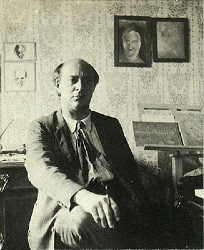
Gurrelieder at the Royal Festival Hall The text is taken from poems by Jens Peter Jacobson, themselves based on medieval legends, which tell the tale of King Waldemar, who loves a young maiden, Tove. Waldemar's queen, Helwig, has Tove murdered. Waldemar rails against God, blaming him for allowing the death of Tove; for this offence he and his dead vassals are forced to ride on a wild hunt every midnight. Only with the return of spring is the curse broken and he is reunited with the soul of Tove. The Gurrelieder is extremely densely scored, with complex orchestral textures whose harmonies are often dissonant, though combining to produce an overall romantic effect. Schoenberg began work on it in 1900 but the work was not premiered until 1913. Its complexity and the large forces mean that it is rarely performed: so yesterday evening's performance at the Royal Festival Hall was a welcome chance to hear it live: even the best recordings and highest quality hi-fi can't do full justice to the quite extraordinary soundstage Schoenberg creates. Esa-Pekka Salonen conducted the Philharmonia Orchestra, the City of Birmingham Symphony Chorus and the Philharmonia Voices; Stig Anderson sung Waldemar and Soile Isokoski sang Tove. Part one of the work runs almost an hour, consisting mostly of linked songs in which Waldemar and Tove declare their love, while being aware of the eventual parting of death: a wild dove (sung by Monica Groop) brings the news of Tove's Death. After the interval came the brief part 2, in which Waldemar accuses God, and straight on to part 3, representing the demonic Wild Hunt. There is a surprising short serio-comic interlude for the King's dead Jester, caught up in the curse, and a final section for a semi-spoken, semi-pitched narration describing the advent of spring: the final release of the curse is celebrated by the chorus - parts 2 and 3 together run some 45 minutes. To hold such huge forces together over such a long work is no mean achievement, and Salonen drew an exciting performance from his soloists and orchestra. The lush and complex romanticism of the love poems and the shattering impact of the Wild Ride made this a considerable musical experience. Posted: Sun - March 1, 2009 at 11:00 AM by Roger Wilmut |
Quick Links
About Me:
Roger Wilmut XML/RSS Feed
MY PODCAST
Archives
Calendar
Blogroll
WEBRINGS
Statistics
Total entries in this category: Published On: Mar 11, 2016 05:00 PM |
||||||||||||||||||


